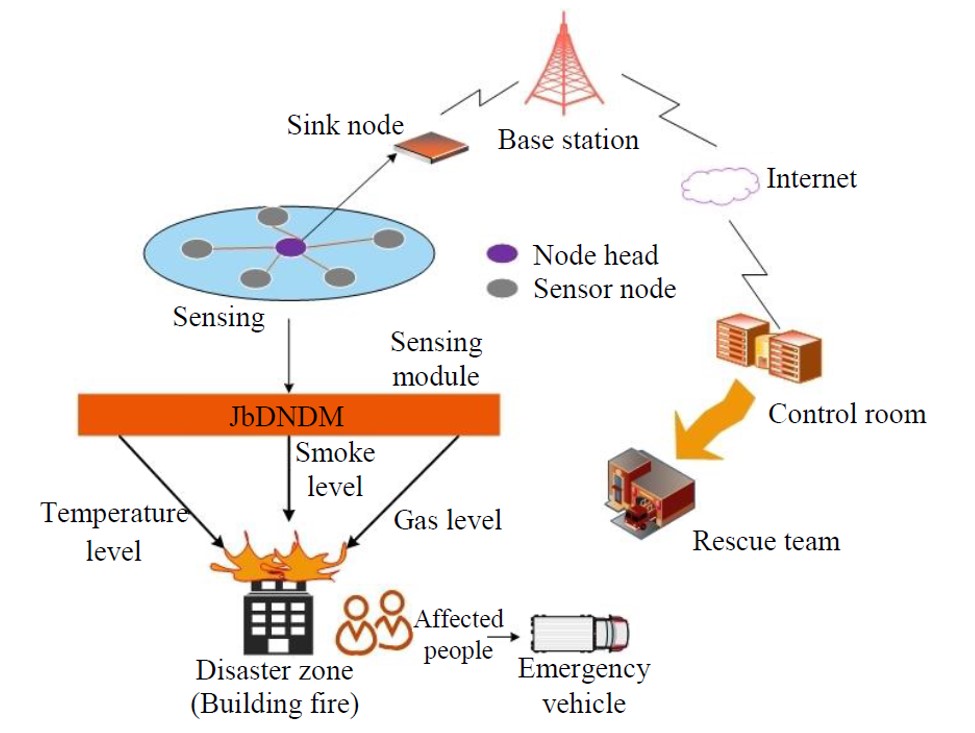An efficient disaster management system based on deep learning in bio-inspired wireless sensor network
Main Article Content
Abstract
The risk rates, such as death, injuries, and distress, are increased in natural and artificial disasters. So, timely control and management of such disasters is a necessary process. The Wireless Sensor Network (WSN) plays a vital role in this process. However, in such techniques, prediction and communication sometimes fail. Therefore, a novel Jellyfish-based Deep Neural Disaster Management (JbDNDM) framework was developed for disaster management phenomena to address these limitations. Initially, the required nodes and network are initialized in the monitoring regions. The proposed JbDNDM system is activated at the sensing module of the network to sense the building fire and the affected zone based on parameters such as smoke, temperature, and gas mixture using the fitness function of the jellyfish and estimating the affected people. The sensed information is then sent to the management to provide emergency favors. Furthermore, the proposed JbDNDM approach was implemented in the MATLAB tool with several performance measurements such as delay, throughput, network lifetime, sensing accuracy, and Packet Delivery Ratio (PDR). The utilization of multi-relay communication increased the network performance, and the jellyfish function increased the sensing accuracy. The network efficiency results were compared with the existing techniques, such as OECF, HMRN, and WWO. The Proposed network obtained 0.01ms delay, 80.01Kbps throughput, 99.7% PDR, and 75h network lifetime. The sensing accuracy of the model is 99%.
Article Details

This work is licensed under a Creative Commons Attribution-NonCommercial-NoDerivatives 4.0 International License.
This work is licensed under a Creative Commons Attribution-NonCommercial-NoDerivatives 4.0 International License.
References
Sethi D, Anand J. Big data and WBAN: prediction and analysis of the patient health condition in a remote area. Eng Appl Sci Res. 2019;46(3):248-55.
Ahmad H, Kohli N. LBCM: Energy-efficient clustering method in wireless sensor networks. Eng Appl Sci Res. 2021;48(5):529-36.
Booranawong A, Sopajarn J, Sittiruk T, Jindapetch N. Reduction of RSSI variations for indoor position estimation in wireless sensor networks. Eng Appl Sci Res. 2018;45(3):212-20.
Singh A, Kotiyal V, Sharma S, Nagar J, Lee CC. A machine learning approach to predict the average localization error with applications to wireless sensor networks. IEEE Access. 2020;8:208253-63.
George R, Mary TAJ. Review on directional antenna for wireless sensor network applications. IET Commun. 2020;14(5):715-22.
Chan L, Chavez KG, Rudolph H, Hourani A. Hierarchical routing protocols for wireless sensor network: a compressive survey. Wireless Netw. 2020;26:3291-314.
Bouakkaz F, Derdour M. Maximizing WSN life using power efficient grid-chain routing protocol (PEGCP). Wireless Pers Commun. 2021;117(2):1007-23.
Wang Z, Ding H, Li B, Bao L, Yang Z. An energy efficient routing protocol based on improved artificial bee colony algorithm for wireless sensor networks. IEEE Access. 2020;8:133577-96.
Behera TM, Samal UC, Mohapatra SK, Khan MS, Appasani B, Bizon N, et al. Energy-efficient routing protocols for wireless sensor networks: architectures, strategies, and performance. Electronics. 2022;11(15):2282.
Adil M, Khan R, Ali J, Roh BH, Ta QTH, Almaiah MA. An energy proficient load balancing routing scheme for wireless sensor networks to maximize their lifespan in an operational environment. IEEE Access. 2020;8:163209-24.
Rouhanizadeh B, Kermanshachi S, Nipa TJ. Exploratory analysis of barriers to effective post-disaster recovery. Int J Disaster Risk Reduct. 2020;50:101735.
Albris K, Lauta KC, Raju E. Disaster knowledge gaps: exploring the interface between science and policy for disaster risk reduction in Europe. Int J Disaster Risk Sci. 2020;11:1-12.
Hallegatte S, Vogt-Schilb A, Rozenberg J, Bangalore M, Beaudet C. From poverty to disaster and back: a review of the literature. Econ Dis Cli Cha. 2020;4:223-47.
Hu X, Naim K, Jia S, Zhengwei Z. Disaster policy and emergency management reforms in China: From Wenchuan earthquake to Jiuzhaigou earthquake. Int J Disaster Risk Reduct. 2021;52:101964.
Feng Y, Cui S. A review of emergency response in disasters: present and future perspectives. Nat Hazards. 2021;105:1109-38.
Li Y, Dong Y, Frangopol DM, Gautam D. Long-term resilience and loss assessment of highway bridges under multiple natural hazards. Struct Infrastruct Eng. 2020;16(4):626-41.
Monteil C, Simmons P, Hicks A. Post-disaster recovery and sociocultural change: rethinking social capital development for the new social fabric. Int J Disaster Risk Reduct. 2020;42:101356.
Mallavalli S, Fekih A. A fault tolerant tracking control for a quadrotor UAV subject to simultaneous actuator faults and exogenous disturbances. Int J Control. 2020;93(3):655-68.
Amiri IS, Prakash J, Balasaraswathi M, Sivasankaran V, Sundararajan TVP, Nour Hindia MHD, et al. DABPR: A large-scale internet of things-based data aggregation back pressure routing for disaster management. Wireless Netw. 2020;26:2353-74.
Sun Y, Mi J, Chen J, Liu W. A new fuzzy multi-attribute group decision-making method with generalized maximal consistent block and its application in emergency management. Knowl Based Syst. 2021;215:106594.
Mohapatra H, Rath AK. Fault‐tolerant mechanism for wireless sensor network. IET Wirel Sens Syst. 2020;10(1):23-30.
Wilson AJ, Radhamani AS. Real time flood disaster monitoring based on energy efficient ensemble clustering mechanism in wireless sensor network. Softw Pract Exper. 2022;52(1):254-76.
Liu S, Zhang D, Liu X, Zhang T, Wu H. Adaptive repair algorithm for TORA routing protocol based on flood control strategy. Comput Commun. 2020;151:437-48.
Anbarasan M, Muthu B, Sivaparthipan CB, Sundarasekar R, Kadry S, Krishnamoorthy S, et al. Detection of flood disaster system based on IoT, big data and convolutional deep neural network. Comput Commun. 2020;150:150-7.
Lino M, Leão E, Soares A, Montez C, Vasques F, Moraes R. Dynamic reconfiguration of cluster-tree wireless sensor networks to handle communication overloads in disaster-related situations. Sensors. 2020;20(17):4707.
Pillai AS, Chandraprasad GS, Khwaja AS, Anpalagan A. A service oriented IoT architecture for disaster preparedness and forecasting system. Internet Things. 2021;14:100076.
Chou JS, Truong DN. A novel metaheuristic optimizer inspired by behavior of jellyfish in ocean. Appl Math Comput. 2021;389:125535.
Mohanadevi C, Selvakumar S. A qos-aware, hybrid particle swarm optimization-cuckoo search clustering based multipath routing in wireless sensor networks. Wireless Pers Commun. 2022;127:1985-2001.
Raja M. PRAVN: perspective on road safety adopted routing protocol for hybrid VANET-WSN communication using balanced clustering and optimal neighborhood selection. Soft Comput. 2021;25(5):4053-72.



